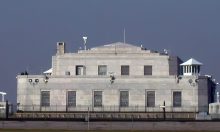
The Bretton Woods Agreement and System Explained
For decades, there have been many scholars and policymakers interested in the global financial system’s transformation. To learn more, they typically look at the Bretton Woods System to understand the concept of a man-made system that introduced stable economic performance to the world during the 1950s and 1960s.
In July 1944, the United States saw the forging of a brand new international monetary system at the hands of delegates from 44 nations. Representatives attending the conference came to an important agreement to go forward with establishing the International Monetary Fund. Moreover, it launched what became the World Bank Group.
The original gold standard
Before Bretton Woods, countries were mostly following the “gold standard.” This meant that each country promised that it would redeem its currency for whatever its value was in gold. However, following Bretton Woods, each member officially settled on redeeming its currency for U.S. dollars instead.
The reason why it was dollars was that the U.S. held three-fourths of the entire world’s gold supply. There was no currency in existence that had enough gold to back it as a replacement. At the time, the value of the dollar was 1/35 of an ounce of gold. Bretton Woods was able to slowly convert the world from a gold standard to a U.S. dollar standard. The dollar was now a substitute for gold and, consequently, the dollar’s value would start to escalate relative to other currencies.
The ensuing transition would generate much more demand for dollars, regardless of its worth in gold remaining unchanged. This inconsistency in value planted the seeds that would grow into the complete collapse of the Bretton Woods System three decades later.
Overall, the Bretton Woods Agreement launched a new global monetary system. It took the place of the gold standard with the U.S. dollar as the global currency. In doing so, it would effectively establish America as the central power source in the world economy. The agreement was signed, and America became the only country in the world that can print dollars.
Bretton Woods Agreement
The creation of the Bretton Woods Agreement took place in a 1944 conference in Bretton Woods, New Hampshire, and consisted of all the Allied nations of World War II. As per the agreement, countries made a vow that their central banks would continue to uphold fixed exchange rates between their currencies and the dollar. In the event of a country’s currency value becoming too weak relative to the dollar, the bank would need to buy up its currency in foreign exchange markets.
It is important to note that purchasing currency would consequently lower the supply of the currency. Not only that, but it would increase its price. Should a currency’s price rise excessively, then the central bank would, in turn, print more. This printing production would lead to a surge in the supply and a decrease in the currency’s price. This strategy is a monetary policy that central banks frequently use to control inflation.
Those attending the conference set out to construct a system that would dodge the general inflexibility of the international monetary systems that came before it. Furthermore, it would bring to light the absence of cooperation among the systems’ countries. After World War I, the classic gold standard was officially abandoned. During the interwar period, governments would not only commence competitive devaluations but also launch restrictive trade policies that made the Great Depression worse.
Bretton Woods System members came to an agreement that they would evade trade wars. For example, they would cease to reduce their currencies solely to boost trade. However, they could regulate their currencies, albeit under certain conditions. They could, for example, act if foreign direct investment starts to undermine their economies. They could also modify their currency values so that they could rebuild following a war.
Bretton Woods System
The leading Bretton Woods System designers were the following:
- John Maynard Keynes, the famous British economist
- Harry Dexter White, the U.S. Treasury Department’s American Chief International Economist
Keynes intended to start a powerful global central bank that would be called the “Clearing Union.” With this, he hoped to distribute “bancor,” a new international reserve currency. White’s vision was to create a comparatively more modest lending fund, as well as a greater role for the U.S. dollar, rather than creating an entirely new currency. What eventually happened was a compromise between the men’s separate concepts. The adopted plan ultimately took ideas from both, though it leaned more towards White’s plan.
The Bretton Woods System did not become fully functional until 1958. Upon implementation, its provisions insisted that the U.S. dollar be pegged to the value of gold. Additionally, all other currencies within the system were to be pegged to the U.S. dollar’s value. The exchange rate at the time established the price of gold at about $35 per ounce.
Once the Bretton Woods System was put into place, it provided nations with more flexibility than stringent adherence to the gold standard. Moreover, it offered less volatility than a currency system that had no standard whatsoever. A member country could still retain the ability to alter the value of its currency if it needed to rectify a “fundamental disequilibrium” in its account balance.
Benefits of Bretton Woods Currency Pegging
In total, the Bretton Woods System included up to 44 countries. Bringing these countries together was out of a desire to have them assist in regulating and promoting international trade across borders. When it comes to the advantages of all currency pegging regimes, there is an expectation of currency pegs to provide currency stabilization for goods and services trading, as well as financing.
All the Bretton Woods System countries made a joint decision to go with a fixed peg against the U.S. dollar. The only diversions that were allowed were of 1%. There was a requirement for countries to continuously oversee and preserve their currency pegs, which they achieved mainly by putting their currency towards buying or selling U.S. dollars. Therefore, the Bretton Woods System lessened volatility concerning the international currency exchange rate.
This, as a result, aided with international trade relations. An increase in foreign currency exchange stability was a key factor in the successful support of international loans and grants deriving from the World Bank.
The IMF and World Bank
The formation of the International Monetary Fund (IMF) occurred in December of 1945 when the first 29 member countries signed its Articles of Agreement. The countries settled on keeping their respective currencies fixed but still adjustable (within the aforementioned 1% band) to the dollar. To reiterate, the dollar had been pegged to gold at $35 per ounce. Even now, whenever a country joins the IMF, it will receive a quota that draws from its relative position in the world economy. This is what determines exactly how much it will contribute to the fund.
Without the IMF, the Bretton Woods System would not have worked out. In fact, it was a vital component if member countries needed to bail themselves out if their currency values fell too far. They would require a specific type of global central bank to borrow from should they need to modify their currency’s value and lacked the funds. They would otherwise simply incorporate trade barriers or increase interest rates.
The Bretton Woods countries decided not to give the IMF the power akin to a global central bank. In place of this, they arranged to provide contributions to a fixed pool of national currencies and gold for the IMF to hold. Member countries of the Bretton Woods System were each permitted to borrow whatever they needed. Of course, it had to be within its contributions’ limits.
At its core, the purpose of the IMF was to enforce the Bretton Woods Agreement. An important note is that the IMF was not invented to print money and shape economies that had monetary policies.
Despite what its name may imply, the World Bank was not – and still isn’t – the central bank of the world. At the time, the World Bank was established as a means to lend to the European countries that were heavily affected by World War II. The World Bank’s objective was changed to lending money to projects of economic development in developing market countries.
The collapse of the Bretton Woods System
The Bretton Woods System was active until 1971. At that point, the U.S. was going through massive stagflation; it was essentially an amalgamation of inflation and recession. This combination was resulting in an unemployment increase and low economic growth. Incessant U.S. balance-of-payments shortfalls would lead to foreign-held dollars surpassing the U.S. gold stock. This implied that the United States was unable to fulfill its duty to redeem dollars for gold at the certified price.
An excessive amount of currency in circulation resulted in a troublesome dip in value. Because of this, President Nixon acted and began to deflate the dollar’s value in gold. He would go on to devalue the dollar to 1/38 of an ounce of gold, then 1/42 of an ounce.
Needless to say, Nixon’s devaluation plan backfired. The outcome was the creation of a run on the U.S. gold reserves at Fort Knox due to so many people redeeming their rapidly devaluing dollars for gold. To fix this problem, Nixon officially disconnected the value of the dollar from gold altogether. With a new lack of price controls, it was not long before gold shot up to $120 per ounce in the free market. This put an end to the Bretton Woods System.
A lasting impact
Though it was discontinued decades ago, the Bretton Woods Agreement remains an important chapter in the history of world finances. The Bretton Woods institutions it built in the IMF and the World Bank played important roles in rebuilding Europe after World War II. In the following years, both institutions still retain their original goals. At the same time, they continue to serve global government interests in the present day.
Make an investment in GoldCoin
Now that you know more about gold. Isn’t it a perfect time to buy today?
Purchase GoldCoin




